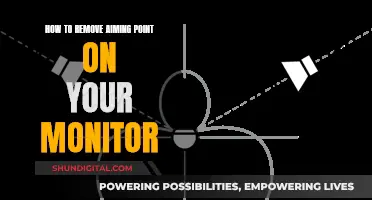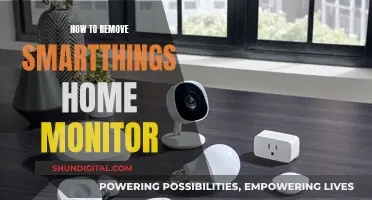
Monitoring your home's electricity usage is a great way to identify areas where energy is being wasted and make small changes to reduce your electricity use. There are several ways to do this, from smart plugs that track individual devices' consumption to whole-home energy monitoring tools that provide a more holistic view of energy usage. These tools can help you see how much energy each device uses, track solar electricity generation and usage, and even detect “vampire loads” – devices that consume power even when they're turned off. By gaining a better understanding of your home's electricity usage, you can make informed decisions to optimise energy usage, reduce your carbon footprint, and save money on your electric bill.
| Characteristics | Values |
|---|---|
| Purpose | Identify and correct energy inefficiencies, save money on electric bills, and reduce carbon footprint |
| Mechanism | Sensors connected to electrical panel/meter; monitor performance and power consumption of appliances; transmit data to phone/computer app |
| Data Provided | Real-time energy usage, cost tracking, appliance-specific information, solar electricity generation, carbon intensity of electricity |
| Installation | Plug into wall socket for individual appliances; attach sensors to circuits in electrical panel for whole-house monitoring (may require electrician) |
| Examples | Sense Energy Monitor, TOPGREENER Smart Outlet, BN-LINK Smart Plug, EMPORIA ENERGY Gen 2 Vue, Eyedro Home Energy Monitor |
What You'll Learn

Smart plugs for individual appliances
Smart plugs are an easy and affordable way to turn ordinary appliances, lighting, and other electronics into smart home devices that you can control straight from your smartphone and, in many cases, your voice. They are a great option for smart-home newbies and enthusiasts alike due to their ease of setup, affordable price, and range of features.
The TP-Link Kasa Smart Wi-Fi Plug Slim (EP25) is the best smart plug for indoor use, as it provides the most features for the best price. It is widely compatible with all the major smart-home platforms and includes real-time energy monitoring and an Away Mode. The TP-Link Kasa Smart Wi-Fi Plug Slim is also available in a mini version, which is a great option if you need to put your smart plug in a tight space.
If you are looking for an outdoor smart plug, the TP-Link Tapo TP25 Outdoor Plug is a good option. It features a robust IP65 weather-resistance rating and independently controllable dual outlets, and it can track device running time.
For those wanting to control multiple devices in one location, the TP-Link Kasa Smart Wi-Fi Power Strip (HS300) is a good choice. It offers six independently controllable outlets and three USB ports. Its 38-inch power cord opens up its placement options, and it has all of the bells and whistles—energy monitoring, sunrise/sunset scheduling, and an Away Mode.
Smart plugs can be an especially useful tool for anyone with mobility and accessibility concerns. They can also be used to monitor energy usage and potentially save money on electricity bills. However, it is important to note that smart plugs do have limitations and are not intended for larger appliances such as laundry machines.
Monitoring Xbox Usage: Remote Control for Parents
You may want to see also

Whole-home electricity monitoring tools
- Sense Energy Monitor — One of the earliest monitors available, Sense uses machine learning to identify individual appliances and their electricity usage. It offers a basic model, as well as upgrades that allow you to monitor solar panel output and/or two sub-circuits. The basic monitor costs $299, while the upgrades are priced at $349 and $499, respectively.
- Generac PWRview W2 — Based on the earlier Neurio W1, this monitor also uses machine learning to identify devices. It is part of Generac's broader green-energy ecosystem, which includes solar panels and solar storage batteries. The PWRview W2 costs less than the Sense monitor.
- Emporia Gen 2 Vue — Unlike the Sense and PWRview, the Emporia Gen 2 Vue does not use machine learning to identify individual electrical loads. Instead, it relies on the user to identify loads by switching devices on and off. The basic system monitors overall energy consumption, but you can add extra sensors to directly measure up to 16 individual circuits. The basic monitor costs less than half the price of the basic PWRview, and less than a third of the price of the basic Sense monitor.
- Eyedro Home Energy Monitor — This monitor has sensors that clip into an electrical panel and feed information to an online dashboard using an Ethernet cable or Wi-Fi connection. It provides real-time energy usage data and allows you to access monitoring reports and bill estimates through the dashboard.
VA's CPAP Monitoring: How It Works and Why
You may want to see also

Appliance recognition features
Appliance recognition is a feature of whole-home energy monitors that allows them to track power consumption by every device plugged into the sockets in your home. These smart systems learn the unique electrical signature of each device and can track them individually.
You can give a unique name to every appliance on the app, so you know which television in the house is switched on or which PC is guzzling power through the night. Knowing how much energy each appliance consumes rather than having a cumulative number for all the devices plugged into a circuit lets you adopt concrete and targeted measures to optimise energy usage.
Some of these monitors with the application recognition feature are so powerful that they can analyse data and detect consumption patterns to give recommendations. For example, they may suggest switching off a device at a specific time during the day, adjusting a programmable thermostat, or upgrading a particular appliance to an energy-efficient model. You can also customise these monitors to alert you about details, such as when a refrigerator door is open.
Appliance recognition allows energy monitors to make more specific recommendations to reduce energy usage. They can send notifications to unplug a blow dryer, adjust a programmable thermostat, or advise which appliances need to be upgraded to a more energy-efficient model. Tracking the energy consumption of each appliance rather than all the appliances attached to a circuit provides specific actions to reduce energy use.
University WiFi: Staff Privacy and Monitoring Concerns
You may want to see also

Real-time cost tracking
Some home energy monitors also allow you to set alerts or notifications for critical use events, peak usage times, or when energy is being wasted. This can help you stay on top of your energy usage and make changes to reduce your consumption and lower your bills.
In addition to tracking your overall energy usage, some home energy monitors can also break down the energy consumption of individual devices or appliances. This can be especially useful for identifying "vampire appliances" that draw power even when they are not in use. By unplugging or replacing these appliances, you can further reduce your energy consumption and lower your costs.
Verizon's Hotspot Usage Monitoring: What You Need to Know
You may want to see also

Mobile apps and notifications
You can set up notifications within the app to alert you about critical use events, peak usage times, and when energy is being wasted. Some apps can also review data collected by sensors and initiate actions, such as powering off an appliance remotely.
- The Green Outlet App: This app helps you monitor the energy usage of your appliances and devices. It also calculates your monthly power costs and alerts you if you exceed the recommended carbon usage based on government regulations.
- Nest Mobile App: The Nest Mobile app works with a Nest thermostat, allowing you to monitor and control your energy consumption even when you're not at home. It also displays a history of your energy usage and provides insights into your devices' energy efficiency.
- Meter Plug: This app transmits data from the plug placed between the electrical outlet and your appliance, allowing you to track the energy usage of individual appliances and calculate the cost of energy consumption based on the time of day.
- Meter Readings App: This app provides a comprehensive record of your home's utility meters, including electricity, gas, and solar energy. It tracks daily energy usage data and compares it with the national average consumption, presented in easy-to-understand graphs.
- Energy Cost Calculator App: This app helps you track the average cost of your appliances and devices by inputting data about their energy consumption. It also calculates your electronics' energy use per year and tracks the amount of CO2 produced by your energy use.
When choosing a home energy monitor, consider factors such as compatibility with your electrical system, solar energy monitoring options, ease of installation, and mobile app functionality.
By utilising these mobile apps and notifications, you can stay informed about your energy usage, make smarter choices, and play an active role in reducing your carbon footprint.
Hilton's Internet Monitoring: What You Need to Know
You may want to see also
Frequently asked questions
You can use a smart plug to track the energy consumption of individual devices. Alternatively, you can use a whole-home electricity monitoring tool, which connects to your home's electrical panel or meter and tracks the energy usage of all the appliances installed in your home.
Monitoring your electricity usage can help you identify areas where energy is being wasted. This will allow you to make small changes, such as unplugging devices that are not in use, to reduce your electricity bill.
A smart plug is a device that fits between the power socket in your wall and an appliance. It allows you to control and monitor the appliance remotely and can be connected to Wi-Fi and controlled via an app or smart home hub.
A smart meter is an electronic device that records and digitally transmits your household's electricity usage. It provides more timely and granular information on your electricity usage than a conventional meter.







